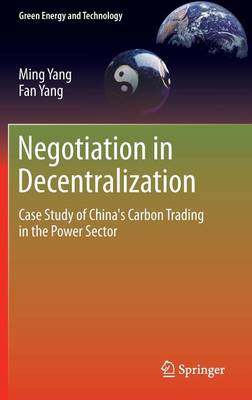Green Energy and Technology
2 total works
The Chinese government set a target to reduce China’s carbon intensity by 40%-45% in 2020 at its 2005 level. To achieve this target, the government has allocated targets to provinces, cities, and large enterprises, and selected five pilot provinces and eight cities for CO2 emission trading. Such emission trading process will involve decentralization, optimization, and negotiation. The prime objective of this book is to perform academic research on simulating the negotiation process. Through this research, a methodological framework and its implementation are set up to analyze, model and facilitate the process of negotiation among central government and individual energy producers under environmental, economical and social constraints.
Negotiation In Decentralization: Case Study Of China's Carbon Trading In The Power Sector discusses research carried out on negotiation issues in China regarding Chinese power sector reform over the past 30 years. Results show that conflicts exist between power groups and the national government, and that the most current negotiation topics in China's power industry are demand and supply management, capital investment, energy prices, and CO2 emission mitigations.
Negotiation In Decentralization: Case Study Of China's Carbon Trading In The Power Sector is written for government policy makers, energy and environment industry investors, energy program and project managers, environment conservation specialists, university professors, researchers, and graduate students. It aims to provide a methodology and a tool that can resolve difficult negotiation issues and change a loss-loss situation to a win-win situation for key players in a decentralized system, including government policymakers, energy producers, and environment conservationists.
This book discusses how energy efficiency benefits the global environment, national energy security, local pollution mitigation, natural resource conservation, and utility bill reduction. In addition, this book provides many hands-on skills and knowledge to identify and develop energy efficiency projects. The literature review shows that energy efficiency has become the first fuel in the world energy supply. With empirical analyses, this book indicates that without continued investment in energy efficiency, neither China nor the U.S. could achieve their carbon emission reduction targets that were announced on November 13, 2014 during the Beijing 2014 APEC meeting. The authors argue that energy efficiency will become the first tool to mitigate climate change. These include (1) identifying energy efficiency barriers, (2) developing energy policies, (3) investing in energy efficient technologies, (4) undertaking project cost-effectiveness analysis, (5) de-risking and financing energy efficiency projects; (6) developing and managing energy service companies, and (7) promoting urban transport efficiency. Two case studies in energy efficiency improvement in electrical motors and industrial boilers are also presented. This book is written for college and university students, practitioners, researchers, consultants, project developers, and policy makers who want to dedicate their professional careers in global energy efficiency improvement, climate change mitigation, local clean air initiatives, and energy bill reduction.

